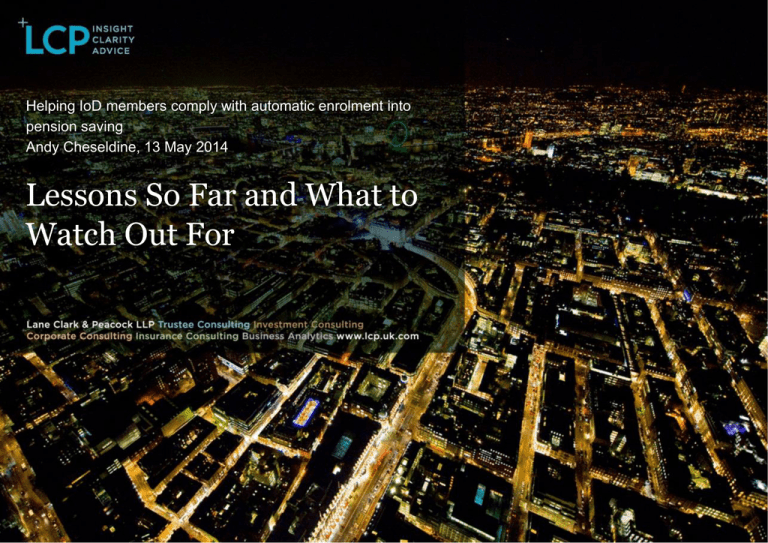The Pensions Regulator
advertisement

Helping IoD members comply with automatic enrolment into pension saving Andy Cheseldine, 13 May 2014 Lessons So Far and What to Watch Out For Agenda In the news… The potential impact on the UK Scoping the issues Some important lessons so far What about the 2014 Budget (and other) reforms? 2 In the news… “Pensions are far too important to be the preserve of the few” Steve Webb “Few will opt out, but AE will not boost engagement” DWP 3 How many workers are affected? Coverage before 2012 Source: ONS & LCP 4 Who needs to be auto-enrolled? Identifying different types of worker (2014/15 thresholds) Age 75 OPT IN Employer contribution (Non-eligible jobholder) SPA OPT IN OPT IN No employer Employer contribution contribution (Entitled worker) (Non-eligible jobholder) AUTO-ENROL Eligible jobholder Qualifying Earnings (QE) 22 OPT IN Employer contribution (Non-eligible jobholder) 16 Earnings £5,772 10,000 £41,865 Qualifying Earnings Earnings Trigger Threshold Upper Limit 5 Quality requirements - DC DC and personal pensions – alternatives allowing certification 8% of Qualifying Earnings (including minimum of 3% from employer) Qualifying earnings must include all variable earnings 9% of pensionable pay (including minimum of 4% from employer) Pensionable pay can exclude variable earnings 8% of pensionable pay (including minimum of 3% from employer) Pensionable pay can exclude variable earnings subject to pensionable pay constituting at least 85% of total pay bill Phasing applies in all approaches “Basic pay” can include other elements of pay that do not vary (eg London Allowance) so potentially not just basic salary 7% of pensionable pay (including minimum of 3% from employer) Subject to 100% of earnings being pensionable 6 Staging and DC phasing Staging date dependent on no. of employees October October October October October October 2012 2013 2014 2015 2016 2017 30 employees Required DC contribution rate (% of QE) Employer 1% Total 2% ER 2% ER 3% Total Total 8% 5% October October October October October October October 2012 2013 2014 2015 2016 2017 2018 7 How does auto-enrolment of non-members affect UK plc? Headcount and earnings in ‘000s, 2013/14 thresholds, 15% opt out rates Auto Enrolment Modeller UK PLc Executive Summary Scheme design Detailed results Parameters Charts and printing Membership summary Current scheme membership Non-members Eligible for auto-enrolment (eligible jobholders) Eligible to opt-in with employer contribution (non-eligible jobholders) Eligible to join without employer contribution (entitled workers) Total Headcount 0 Total annual earnings (£) 0 Earnings % 0.0% 8,475 184,965,040 82.1% 2,841 29,949,400 13.3% 2,197 10,409,880 4.6% 13,513 225,324,320 100.0% Numbers of employees Summary of results Net annualised cost increase/(decrease) - assuming no change for current scheme members All employees (incl current scheme members) Before 2017 2017/18 2018/19 £pa £pa £pa Minimum Contributions based on Qualifying Earnings 1,170,793 2,341,585 3,512,378 9% Certification 2,745,487 4,118,231 5,490,974 8% Certification 1,372,744 2,745,487 4,118,231 7% Certification 1,592,382 3,184,765 4,777,147 Existing scheme design 644,659 644,659 644,659 Alternative scheme design 9,313,755 9,313,755 9,313,755 Source: ONS 2011 data & LCP Current scheme membership Eligible jobholders Non-eligible jobholders Entitled workers 8 Employer numbers (1) PAYE schemes by staging date – Oct 2012 to May 2015 14,000 12,000 10,000 8,000 6,000 4,000 2,000 May-15 Apr-15 Mar-15 Feb-15 Jan-15 Dec-14 Nov-14 Oct-14 Sep-14 Aug-14 Jul-14 Jun-14 May-14 Apr-14 Mar-14 Feb-14 Jan-14 Dec-13 Nov-13 Oct-13 Sep-13 Aug-13 Jul-13 Jun-13 May-13 Apr-13 Mar-13 Feb-13 Jan-13 Dec-12 Nov-12 Oct-12 - These figures are from the Pensions Regulator and reflect the number of PAYE schemes not the number of employers. Employers may have more than one PAYE scheme. Source: NEST, 2013 9 Employer numbers (2) PAYE schemes by staging date – Oct 2012 to Feb 2018 160,000 140,000 120,000 100,000 80,000 60,000 40,000 20,000 Feb-18 Dec-17 Oct-17 Aug-17 Jun-17 Apr-17 Feb-17 Dec-16 Oct-16 Aug-16 Jun-16 Apr-16 Feb-16 Dec-15 Oct-15 Aug-15 Jun-15 Apr-15 Feb-15 Dec-14 Oct-14 Aug-14 Jun-14 Apr-14 Feb-14 Dec-13 Oct-13 Aug-13 Jun-13 Apr-13 Feb-13 Dec-12 Oct-12 - These figures are from the Pensions Regulator and reflect the numbers of PAYE schemes not the numbers of employers. Employers may have more than one PAYE scheme. Source: NEST, 2013 10 Market capacity constraints Estimated numbers of auto-enrolments and event transactions (Public & Private sector ) 800,000 700,000 Number of AE events 600,000 500,000 400,000 Number of AE events 300,000 Number of event transactions 200,000 100,000 Feb-18 Dec-17 Oct-17 Aug-17 Jun-17 Apr-17 Feb-17 Dec-16 Oct-16 Aug-16 Jun-16 Apr-16 Feb-16 Dec-15 Oct-15 Aug-15 Jun-15 Apr-15 Feb-15 Dec-14 Oct-14 Aug-14 Jun-14 Apr-14 Feb-14 Dec-13 Oct-13 Aug-13 Jun-13 Apr-13 Feb-13 Dec-12 Oct-12 0 Date Source: DWP, TPR, BIS, ONS, LCP Event transactions include: opt outs, opt ins, leavers (personal decision & employer insolvency), retirements & deaths. They exclude calls to helplines, changes of address, changes of name, divorce and transfers Assumes steady state private sector employment, 12% pa private sector DB closure & no use of waiting periods 11 Some important lessons Pre–assessment Are you confident of identifying all your workers? Opt out rates Are lower than many expected – Less than 10% but…. Scheme leaver rates Are likely to be at least as important as opt outs Payroll providers Are crucial to the success of any AE project Focus on the data How good is your employee data? The boring stuff matters Mitigations Most employers, so far, are using postponement Providers May not want your business, at least on the terms you expect Early engagement Internally an externally is likely to save money and worry Contribution costs Are the least of your worries 12 The old landscape 25% tax free lump sum Full withdrawal (at marginal rate) Pension pot Annuity Small pots or trivial pensions Full withdrawal (55% tax charge) Flexible Drawdown Capped Drawdown Big pots 13 Immediate changes in Budget 2014 With effect from 27 March 2014… Capped drawdown: 150% Flexible drawdown: £12,000 Small pots as lump sums: 3 schemes Small pension pots: £10,000 Trivial commutation: £30,000 14 The new landscape After April 2015 25% tax free lump sum Full withdrawal (at marginal rate) Pension pot Annuity Drawdown / other products 15 DC investment funds for the new world What decisions do you need to make? Key decisions Is current default strategy appropriate? What is the target “retirement” age now? Is more than one lifestyle needed? What is the exposure to growth assets during retirement? Key considerations Limitations of your provider / administrator Importance of liquidity Member demographic Interaction with communication plan Key decision ages 16 Unintended (?) consequences What Members have flexibility to take 100% cash at age 55 Potential unintended consequences Raithatha v Williamson (4 April 2012) [Bankruptcy] and Blight and others v Brewster (9 February 2012) [Judgment Creditors] meant creditors can enforce debtors to take tax free cash • Will the same rule apply to taxable cash? • Irrespective of resulting marginal tax rate? • What about Local Councils seeking social care funding for nursing homes? • Is that a problem? If members take that cash Do they understand it is no longer protected from inheritance tax? Guidance guarantee What will it cover? Who will provide it? What will it cost? Who will pay for it? When will it be provided (and how often)? Who will regulate it? Taxed at marginal rate in that year Possibly treated as flexible drawdown Well informed members will want to retire near the beginning of a tax year What does that mean for HR/ Succession planning? If current rules continue, that will mean members are taxed at top marginal rate on all future pension contributions 17 Charges Command paper When April 2015 What Charges (TERs) capped at 0.75% for default investment option in qualifying pension schemes No “comply or explain” option Active member discounts (“AMD”) banned on qualifying pension schemes April 2016 Commission banned on qualifying pension schemes Potential unintended consequences Providers are considering moving to NEST /Now charge design (eg 2.5% contribution charge plus 0.4% AMC) Applies to all qualifying schemes – potentially including historic DC schemes without a “default” but with a “typical” investment choice (with profits?) DWP include as AMD, schemes that pay admin costs for active members but not deferred members What service levels can you expect form commission based IFAs? Will that cap include: April 2017 Charges cap reviewed with intent to reduce and/or include transaction costs • • • • • Guidance guarantee Provision of flexible drawdown post NRD EIOPA governance fees and costs Financial Transaction Tax (in costs) Administration of the Scottish Rate of Income Tax 18 Effect on auto-enrolment? For employees: Greater flexibilities are incentives to save For providers: Uncertainty over future profit margins (charges and cost of additional services) Fewer annuity sales Impact on gilt and bond market Future tax / legislation also unclear For employers: Harder to find pension provider willing to take on small schemes And fewer services available Payroll providers will be tied up with Scottish rate of income tax Possibly harder to find advisers (as some may focus on retirement advice following Budget) – however unlikely to be too much overlap with corporate advisers Higher take up from employees 19 How successful will auto-enrolment be? Scope This generic presentation should not be relied upon for detailed advice or taken as an authoritative statement of the law. If you would like any assistance or further information, please contact the partner who normally advises you. While this document does not represent our advice, nevertheless it should not be passed to any third party without our formal written agreement. The tax examples given are purely for illustration and ignore tax allowances and other important details. © Lane Clark & Peacock LLP 2014 LCP is part of the Alexander Forbes Group, a leading independent provider of financial and risk services. Lane Clark & Peacock LLP is a limited liability partnership registered in England and Wales with registered number OC301436. LCP is a registered trademark in the UK (Regd. TM No 2315442) and in the EU (Regd. TM No 002935583). All partners are members of Lane Clark & Peacock LLP. A list of members’ names is available for inspection at 95 Wigmore Street, London, W1U 1DQ, the firm’s principal place of business and registered office. The firm is regulated by the Institute and Faculty of Actuaries in respect of a range of investment business activities. Locations in London, Winchester, Belgium, the Netherlands, Ireland and the UAE. W:\ARC\Non client related\PR\Confrerence presentations\IoD 13 May 2014.pptx Helping IoD members comply with automatic enrolment into pension saving Andy Cheseldine, 13 May 2014 Lessons So Far and What to Watch Out For







